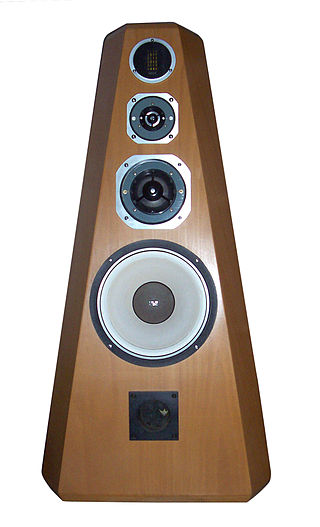
High fidelity is the high-quality reproduction of sound. It is popular with audiophiles and home audio enthusiasts. Ideally, high-fidelity equipment has inaudible noise and distortion, and a flat frequency response within the human hearing range.

Digital Audio Tape is a signal recording and playback medium developed by Sony and introduced in 1987. In appearance it is similar to a Compact Cassette, using 3.81 mm / 0.15" magnetic tape enclosed in a protective shell, but is roughly half the size at 73 mm × 54 mm × 10.5 mm. The recording is digital rather than analog. DAT can record at sampling rates equal to, as well as higher and lower than a CD at 16 bits quantization. If a comparable digital source is copied without returning to the analogue domain, then the DAT will produce an exact clone, unlike other digital media such as Digital Compact Cassette or non-Hi-MD MiniDisc, both of which use a lossy data-reduction system.

Binaural recording is a method of recording sound that uses two microphones, arranged with the intent to create a 3D stereo sound sensation for the listener of actually being in the room with the performers or instruments. This effect is often created using a technique known as dummy head recording, wherein a mannequin head is fitted with a microphone in each ear. Binaural recording is intended for replay using headphones and will not translate properly over stereo speakers. This idea of a three-dimensional or "internal" form of sound has also translated into useful advancement of technology in many things such as stethoscopes creating "in-head" acoustics and IMAX movies being able to create a three-dimensional acoustic experience.
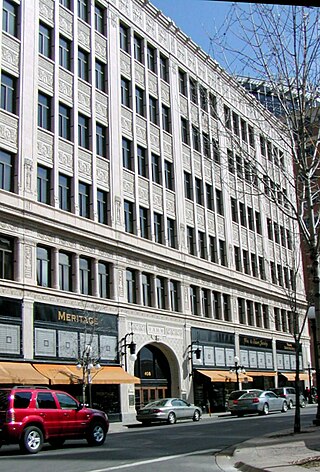
The Saint Paul Chamber Orchestra (SPCO) is a full-time professional chamber orchestra based in Saint Paul, Minnesota. In collaboration with five Artistic Partners, the orchestra's musicians present more than 130 concerts and educational programs each year in over 14 venues throughout the Minneapolis/St. Paul area. They are regularly heard on American Public Media's nationally syndicated radio programs "Performance Today" and SymphonyCast.

A recording studio is a specialized facility for recording and mixing of instrumental or vocal musical performances, spoken words, and other sounds. They range in size from a small in-home project studio large enough to record a single singer-guitarist, to a large building with space for a full orchestra of 100 or more musicians. Ideally, both the recording and monitoring spaces are specially designed by an acoustician or audio engineer to achieve optimum acoustic properties.

Multitrack recording (MTR), also known as multitracking, is a method of sound recording developed in 1955 that allows for the separate recording of multiple sound sources or of sound sources recorded at different times to create a cohesive whole. Multitracking became possible in the mid-1950s when the idea of simultaneously recording different audio channels to separate discrete tracks on the same reel-to-reel tape was developed. A track was simply a different channel recorded to its own discrete area on the tape whereby their relative sequence of recorded events would be preserved, and playback would be simultaneous or synchronized.

The Fairlight CMI is a digital synthesizer, sampler, and digital audio workstation introduced in 1979 by Fairlight. It was based on a commercial licence of the Qasar M8 developed by Tony Furse of Creative Strategies in Sydney, Australia. It was one of the earliest music workstations with an embedded sampler and is credited for coining the term sampling in music. It rose to prominence in the early 1980s and competed with the Synclavier from New England Digital.
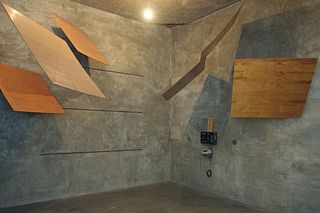
An echo chamber is a hollow enclosure used to produce reverberation, usually for recording purposes. A traditional echo chamber is covered in highly acoustically reflective surfaces. By using directional microphones pointed away from the speakers, echo capture is maximized. Some portions of the room can be moved to vary the room's decay time. Nowadays, effects units are more widely used to create such effects, but echo chambers are still used today, such as the famous echo chambers at Capitol Studios.
The music of Minnesota began with the native rhythms and songs of Indigenous peoples, the first inhabitants of the lands which later became the U.S. state of Minnesota. Métis fur-trading voyageurs introduced the chansons of their French ancestors in the late eighteenth century. As the territory was opened up to white settlement in the 19th century, each group of immigrants brought with them the folk music of their European homelands. Celtic, German, Scandinavian, and Central and Eastern European song and dance remain part of the vernacular music of the state today.
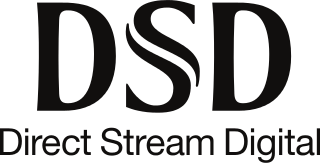
Direct Stream Digital (DSD) is a trademark used by Sony and Philips for their system for digitally encoding audio signals for the Super Audio CD (SACD).

In digital recording, an audio or video signal is converted into a stream of discrete numbers representing the changes over time in air pressure for audio, or chroma and luminance values for video. This number stream is saved to a storage device. To play back a digital recording, the numbers are retrieved and converted back into their original analog audio or video forms so that they can be heard or seen.

Stereophonic sound, or more commonly stereo, is a method of sound reproduction that recreates a multi-directional, 3-dimensional audible perspective. This is usually achieved by using two independent audio channels through a configuration of two loudspeakers in such a way as to create the impression of sound heard from various directions, as in natural hearing.

Flim & the BB's was a contemporary jazz band that was among the first bands to record albums digitally.

DMP Digital Music Products was one of the first digital recording labels, generally specializing in jazz artists. DMP was founded in 1983 by engineer Tom Jung after leaving Sound 80 recording studios in Minneapolis, Minnesota.

Richard Dennis Oatts is an American jazz saxophonist, multi-instrumentalist, composer, and educator.
A mastering engineer is a person skilled in the practice of taking audio that has been previously mixed in either the analogue or digital domain as mono, stereo, or multichannel formats and preparing it for use in distribution, whether by physical media such as a CD, vinyl record, or as some method of streaming audio.

An audio engineer helps to produce a recording or a live performance, balancing and adjusting sound sources using equalization, dynamics processing and audio effects, mixing, reproduction, and reinforcement of sound. Audio engineers work on the "technical aspect of recording—the placing of microphones, pre-amp knobs, the setting of levels. The physical recording of any project is done by an engineer…"

Feels Like Home is a studio album by American singer Linda Ronstadt released in 1995. It reached #75 and lasted 12 weeks on the Billboard album chart. It received excellent critical reviews upon release. According to Nielsen SoundScan, the disc sold 188,815 copies in the United States. This album is now out of print physically, although it is available digitally and five of its tracks were remixed and subsequently included on Trio II.
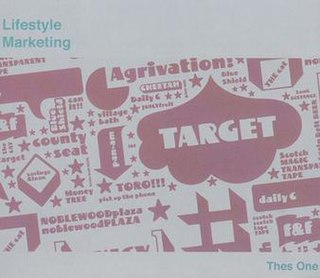
Lifestyle Marketing is the debut studio album by producer and musician Thes One. It is an instrumental concept album consisting almost entirely of samples taken from radio and television advertising jingles created by Herb Pilhofer of Sound 80 Incorporated.
Orfield Laboratories is a Minneapolis multi-sensory design research laboratory consulting in architectural and product development and research. It was founded in 1971 by Steven J Orfield. Inside the building is an anechoic chamber that is one of the quietest places on earth, absorbing 99.9% of sound. The room attracts media attention and inspires rumors and speculation about the psychological effects of spending time in silence.


















